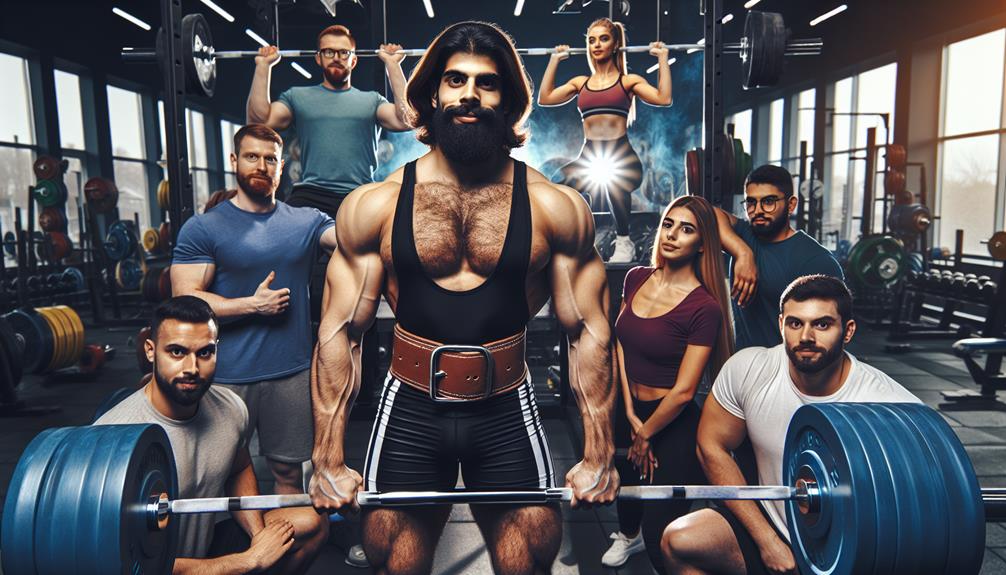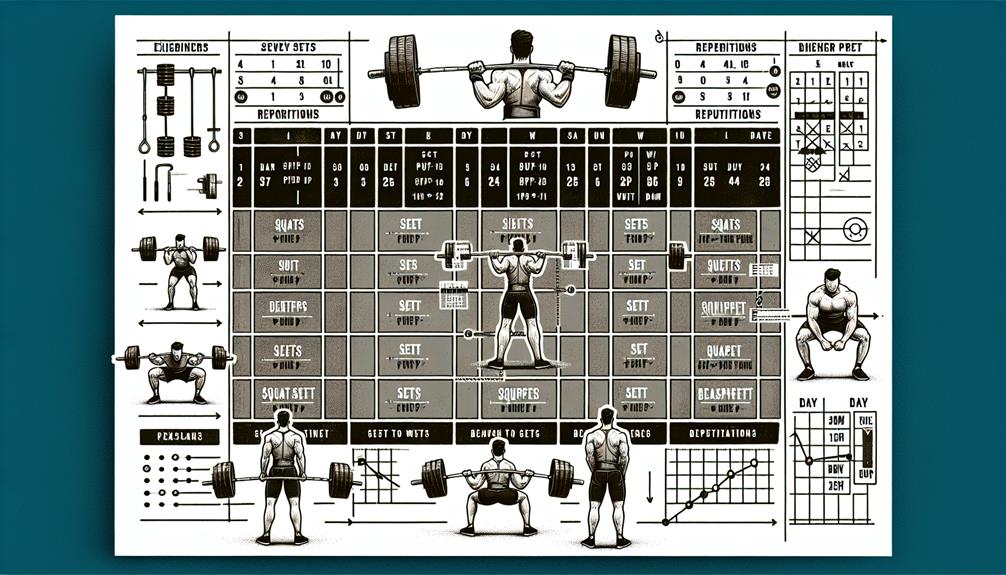Step onto the weightlifting platform of powerlifting, where strength meets determination and progress flows through every lift. As a beginner, you may feel like a seed ready to sprout, eager to grow and make your mark in the world of strength training. But where do you start? How do you navigate the intimidating world of powerlifting and build a solid foundation? Fear not, for this step-by-step workout guide will be your compass, leading you through the realm of powerlifting, unveiling the essentials, techniques, and strategies that will transform you into a force to be reckoned with. Are you ready to unlock your true strength potential?
Key Takeaways
- Powerlifting can improve strength, muscle growth, and overall physical appearance.
- Proper equipment, such as powerlifting belts and wrist wraps, can provide support and prevent injuries.
- Warm-up and stretching techniques are essential to prepare the body for powerlifting exercises.
- Mastering the basic powerlifting movements, such as squats, bench press, and deadlifts, is crucial for success in powerlifting.
The Benefits of Powerlifting

Powerlifting offers a multitude of benefits that can help you transform your body and improve your overall strength and fitness levels. One of the key benefits of powerlifting is improved strength and muscle growth. By regularly engaging in powerlifting exercises, such as squats, deadlifts, and bench presses, you can progressively increase the amount of weight you lift, which in turn stimulates the development of stronger and larger muscles. This increased muscle mass not only enhances your physical appearance but also boosts your ability to perform everyday tasks and athletic activities.
Another benefit of powerlifting is increased bone density. The heavy weightlifting involved in powerlifting puts stress on your bones, forcing them to adapt and become stronger. This is especially beneficial for individuals at risk of osteoporosis or those looking to prevent age-related bone loss. By regularly participating in powerlifting, you can significantly improve your bone density and reduce the risk of fractures.
Powerlifting is not only beneficial for your physical well-being but also for your mental health. Engaging in regular strength training has been shown to release endorphins, which are natural mood enhancers. This can help reduce symptoms of depression, anxiety, and stress. Additionally, the sense of accomplishment and self-confidence gained from reaching new personal records in powerlifting can have a positive impact on your overall mental well-being.
Essential Equipment for Powerlifting
Now that you understand the numerous benefits of powerlifting, let's dive into the essential equipment you'll need to get started with this empowering strength training regimen. Having the right powerlifting gear is crucial to ensure your safety, improve your performance, and maximize your gains. Here are some equipment recommendations to consider:
| Equipment | Description |
|---|---|
| Powerlifting Belt | Provides support to your lower back and core during heavy lifts. |
| Wrist Wraps | Stabilizes your wrists and helps prevent injuries. |
| Knee Sleeves | Provides compression and support to your knees. |
| Weightlifting Shoes | Offers stability and optimal foot positioning during lifts. |
These four items are the basic essentials for any powerlifter. Of course, as you progress in your journey, you may choose to invest in additional gear such as lifting straps, knee wraps, or a lifting singlet. However, starting with the basics is more than enough to get you started.
When it comes to purchasing powerlifting gear, it's important to invest in quality products that are durable and provide the necessary support. Look for reputable brands that specialize in powerlifting equipment and read reviews from other lifters to ensure you're making the right choice.
Now that you know the essential equipment needed for powerlifting, it's time to gather your gear, hit the gym, and start your journey towards becoming a stronger and more empowered version of yourself.
Proper Warm-up and Stretching Techniques

Looking to maximize your performance and prevent injuries during your powerlifting workouts? Proper warm-up and stretching techniques are crucial for preparing your muscles and joints for the demands of lifting heavy weights. Here are some steps you can follow to ensure an effective warm-up routine:
- Start with a dynamic warm-up: Perform exercises that mimic the movements you will be doing during your workout. This will increase blood flow, loosen up your muscles, and improve your range of motion.
- Incorporate foam rolling techniques: Foam rolling helps to release muscle tension and improve flexibility. Roll slowly over each muscle group for about 30 seconds to alleviate any tightness or knots.
- Stretch major muscle groups: Focus on stretching your hamstrings, quadriceps, hip flexors, chest, and shoulders. Hold each stretch for at least 20 seconds to improve flexibility and prevent muscle imbalances.
- Warm-up sets: Before starting your working sets, perform a few lighter sets with gradually increasing weight. This will further activate your muscles and prepare them for heavier loads.
- Listen to your body: Pay attention to any discomfort or pain during your warm-up. If something doesn't feel right, adjust your technique or seek professional advice.
Mastering the Basic Powerlifting Movements
To ensure your success in powerlifting, it's essential to become proficient in the fundamental movements that form the foundation of this sport. Mastering these basic powerlifting movements will not only help you build strength but also prevent common powerlifting mistakes. Let's dive into the key movements you need to focus on to excel in powerlifting.
- Squat: The squat is a compound movement that targets your legs, glutes, and core. Start with a shoulder-width stance, keeping your chest up and back straight. Descend by bending your knees and hips until your thighs are parallel to the ground. Push through your heels to return to the starting position.
- Bench Press: The bench press primarily works your chest, shoulders, and triceps. Lie on a bench with your feet flat on the ground. Grip the bar slightly wider than shoulder-width apart. Lower the barbell to your chest, then press it back up until your arms are fully extended.
- Deadlift: The deadlift targets your entire posterior chain, including your back, glutes, and hamstrings. Stand with your feet shoulder-width apart, gripping the bar just outside your legs. Keep your back straight as you lift the barbell off the ground, pushing through your heels and engaging your glutes.
Designing an Effective Powerlifting Program

To develop an effective powerlifting program, you need to carefully plan and structure your training sessions, focusing on key elements such as exercise selection, volume and intensity, progressive overload, and adequate rest and recovery. By following these programming principles, you can optimize your progress and avoid plateaus. Here are some steps to help you design an effective powerlifting program:
- Exercise Selection: Choose compound exercises that target multiple muscle groups, such as squats, deadlifts, and bench presses. These movements will allow you to lift heavier weights and build overall strength.
- Volume and Intensity: Gradually increase the number of sets and reps you perform, as well as the weight you lift. This will help you build muscle and improve your strength over time.
- Progressive Overload: Continuously challenge your body by increasing the weight you lift. This will stimulate muscle growth and strength gains.
- Tracking Progress: Keep a record of your lifts, sets, reps, and weights used. This will help you track your progress and make adjustments to your program as needed.
- Rest and Recovery: Allow yourself enough time to rest and recover between training sessions. This will prevent overtraining and reduce the risk of injury.
Frequently Asked Questions
Can Powerlifting Help Me Lose Weight?
Yes, powerlifting can help you lose weight. By incorporating powerlifting into your fitness routine, you can burn calories, increase muscle mass, and boost your metabolism, leading to long-term weight loss and improved body composition.
How Long Does It Take to See Results From Powerlifting?
You'll start seeing results from powerlifting within a few weeks. However, the powerlifting progress timeline varies depending on factors like your commitment, nutrition, and genetics. Consistency and hard work are key to achieving your goals. Keep pushing!
Is Powerlifting Safe for People With Pre-Existing Injuries?
Powerlifting can be safe for people with pre-existing injuries if done properly. Start by consulting a professional, focus on injury rehabilitation, and prioritize joint health. With the right approach, powerlifting can be a beneficial part of your fitness journey.
Can I Do Powerlifting if I Don't Have Access to a Gym?
You can still do powerlifting at home without a gym. Try alternative exercises like bodyweight squats, push-ups, and resistance band training. Focus on building strength and gradually increase the intensity of your workouts.
Are There Any Age Restrictions for Powerlifting?
Age is just a number when it comes to powerlifting. Whether you're a young gun or a seasoned senior, powerlifting can be for you. Embrace the challenge, train smart, and push your limits. You got this!
Conclusion
Congratulations! You've now unlocked the gateway to your untapped potential. Powerlifting, with its myriad benefits and essential equipment, is a journey worth embarking on. By mastering the basic movements and designing an effective program, you'll witness the transformation of your body and mind. So, grab that barbell and let it be your companion on this exhilarating path of strength. Remember, the only limit is the one you set for yourself. Embrace the challenge and soar to new heights. Powerlifting awaits you!












